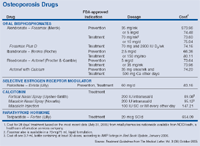Effective medicines now available to combat osteoporosis
In the United States today, 10 million people have osteoporosis (bone density that's about 25% less than a healthy young adult). In addition, 34 million more people have low levels of bone mass, placing them at increased risk. Osteoporosis is responsible for more than 1.5 million fractures annually, including 300,000 hip fractures, approximately 700,000 vertebral fractures, 250,000 wrist fractures, and more than 300,000 other fractures. About 68% of those affected by osteoporosis are women.

The best way to prevent this disease is a comprehensive approach that includes diet, weight-bearing exercise, limited alcohol consumption and no smoking. In addition, bone density testing and appropriate medications are used as needed.
SEVERAL MEDICATIONS TARGET OSTEOPOROSIS
Bisphosphonates can cause heartburn, esophageal irritation, abdominal pain and other gastrointestinal effects. To ensure proper absorption, they must be taken after an overnight fast, in an upright position, and then the patient must remain upright for 30 minutes. "The bisphosphonates have been shown to be effective in preventing fractures in postmenopausal women with osteoporosis, and they all appear to be relatively safe," says Mark Abramowicz, MD, editor of The Medical Letter on Drugs and Therapeutics, a non-profit newsletter that critically appraises drugs. "Weekly or monthly doses have been as effective as daily doses. In the future, bisphosphonate injections at intervals as long as a year may prove to be effective alternatives."
Evista (raloxifene) is a selective estrogen receptor modulator (SERM), which means it has been developed to provide the beneficial effects of estrogens without some of their disadvantages. Evista increases bone mass and reduces the risk of spine fractures, although there is no evidence yet to show that it can reduce the risk of hip and other non-spine fractures. In addition, it appears to substantially decrease the risk of estrogen-dependent breast cancer. Side effects include hot flashes and leg cramps, and Evista leads to a small increase in the risk of deep vein thrombosis and pulmonary embolism.
Calcitonin, available under the brand names Miacalcin, Calcimar and Fortical, is a peptide hormone approved by the FDA for treatment, but not prevention, of osteoporosis. It is taken intranasally, or as a subcutaneous injection. In addition to decreasing bone resorption, it also may have a pain-relieving effect.
A recently approved medication, Forteo (teriparatide, a form of parathyroid hormone) is the first osteoporosis medication that increases the rate of bone formation in the bone remodeling cycle. In one study, women who received daily injections of Forteo for 21 months had a decreased incidence of vertebral fractures (4.5% in the study group compared with 14% in the placebo group).
"We've made enormous progress in osteoporosis treatment," says Felicia Cosman, MD, clinical director of the National Osteoporosis Foundation. "Over the last decade, we've seen the advent of at least six new therapies for osteoporosis, and they're all effective. Obviously treatment needs to be individualized."
Selecting the preferred medication for a particular patient depends on many factors, including age, family history, underlying diseases, how low bone density is, and whether there are any fractures.
"For most people, we start with the bisphosphonates because those medications have the strongest evidence for actually preventing fractures," says Fred Heidrich, MD, a faculty physician in the family practice residency of Group Health Cooperative, a staff model health plan. "Their side-effect profile is quite good in selected candidates, but you can't give bisphosphonates to someone who has low calcium or bad kidneys."
David Calabrese of OptumRx Talks New Role, Market Insulin Prices and Other Topics 'On His Mind'
April 13th 2023In this month’s episode of the "What's On Your Mind podcast," Peter Wehrwein, managing editor of MHE connects with the now Chief Clinical Officer of OptumRx Integrated Pharmacies, David Calabrese. In this conversation, David touches on his transition in January as OptumRx’s former chief pharmacy officer and market president of health plans and PBMs to his new role as Chief Clinical Officer where he now focuses more on things such as specialty pharmacy to home delivery — with an overall goal of creating whole-patient care. Throughout the conversation, Calabrese also touched on the market’s hot topic of insulin prices and behavioral health services within the OptumRx community, among other topics.
Listen
Upended: Can PBM Transparency Succeed?
March 6th 2024Simmering tensions in the pharmacy benefit management (PBM) industry have turned into fault lines. The PBMs challenging the "big three" have formed a trade association. Purchaser coalitions want change. The head of the industry's trade group says inherent marketplace friction has spilled over into political friction.
Read More
Briana Contreras, editor of Managed Healthcare Executive, spoke with Nancy Lurker, CEO and president of EyePoint Pharmaceuticals. Nancy shared a bit about EyePoint and how the organization’s innovative therapies are addressing patient needs through eye care, and most importantly, she addressed C-Suite positions like the CEO role. Nancy shared advice for those seeking to reach the CEO level, especially toward women in healthcare and other roles, and what it takes to run a biopharma company.
Listen
The deliberate disconnection of Change Healthcare to ring fence a cyberattack entered its seventh day today. Prescribers are finding ways to get pharmacy claims processed, and UnitedHealth Group says disruption to the dispensing of prescriptions has been minimal. But independent pharmacies want more information and protection from financial consequences from pharmacy benefit managers.
Read More